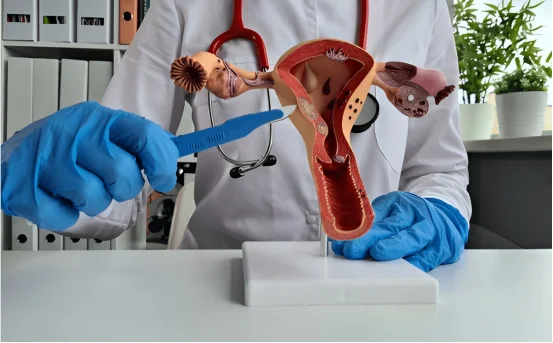A minimally-invasive gynecological surgery is used to diagnose and treatment problems within the uterus. The hysteroscope is a thin, lighted instrument that is inserted into the vagina in order to examine the cervix. This allows your doctor view the uterine cavities on a screen, and treat problems without having to make any external incisions.
hysteroscopic surgery may be either diagnostic or operative . Diagnostic hysteroscopy is used to investigate abnormal uterine conditions. Operative hysteroscopy treats intrauterine issues. When is this procedure needed?
1. Uterine Fibroids (Submucosal Fibroids)
One of the most common causes of hysteroscopic surgery is the presence of submucosal fibroids–noncancerous growths that develop within the uterine lining. These can lead to:
- Menstrual bleeding that is heavy or prolonged
- Pelvic pain, pressure and discomfort
- Infertility and difficulty maintaining pregnancy
The hysteroscopic myomectomy removes fibroids through the cervix. This preserves the uterus, and can often improve fertility.
2. Uterine polyps
Endometrial Polyps are benign, soft growths that attach to the inner wall. These polyps may cause:
- Irregular menstrual bleeding
- Bleeding after menopause
- Bleeding between periods
- Infertility can occur in certain cases
The hysteroscopic polypectomy procedure is quick and can improve symptoms as well as fertility.
3. Abnormal Uterine Blood (AUB)
The most common reason for hysteroscopy is abnormal uterine blood flow. This refers to any abnormal bleeding, which is different from the normal menstrual flow.
- Very heavy periods (menorrhagia)
- Bleeding between periods
- Bleeding after menopause
Hysteroscopy can be used to diagnose and treat the underlying problem, such as fibroids, polyps or hyperplasia.
4. Uterine septum or congenital Uterine abnormalities
Some women have congenital abnormalities in the uterus. For example, a septum — a band of tissue that divides the uterine cavity. These abnormalities may cause:
- Recurrent miscarriages
- Infertility
- Complications during pregnancy
This condition can be corrected by hysteroscopic metroplasty, which removes the septum. It increases the chance of getting pregnant.
5. Intrauterine adhesions (Asherman syndrome)
Intrauterine Adhesions is a band of scar tissue inside the uterus that forms due to infections, surgeries or trauma. This condition is known as Asherman Syndrome and can cause:
- Periods of irregularity or absence
- Infertility
- Miscarriages
The adhesions are removed by cutting them and returning the uterine cavity to normal.
6. Retained Products of Conception
After miscarriage or abortion, residual tissue in the uterus may lead to:
- Long-term bleeding
- Infection
- Uterine pain
Hysteroscopic surgery removes the retained products completely and safely, reducing infection risk and scarring.
7. Evaluation and biopsy of Uterine Abnormalities
Hysteroscopy is used if imaging tests reveal a suspicious thickening (endometrial Hyperplasia) of the uterine lining or possible endometrial carcinoma .
- Visualize the uterine lining directly
- Take a biopsy sample
- Remove abnormalities by removing them at a specific location
The hysteroscopy procedure is more accurate than blind biopsies.
8. Infertility Investigations
Hysteroscopy can provide valuable insight into the structural abnormalities which may interfere with embryo or implantation development. The most common findings are:
- Polyps and fibroids
- Uterine septum
- Adhesions and scar tissue
Treatment of these problems through operative hysteroscopy may improve reproductive outcomes.
9. Cervical issues and abnormal Pap Smears
When a colposcopy or Pap test shows abnormal cells but is not conclusive, the hysteroscopy can be used to check the endocervical cavity and uterine cavity.
- Precancerous changes
- Uterine lesions
- Endometrial abnormalities
Early detection of cancers in the uterus and cervix is possible.
10. Foreign Bodies in Uterus
Foreign objects, such as:
- IUDs that are displaced or embedded
- Non-degradable contraceptive implants
Can cause pain, bleeding, or infection. Hysteroscopic surgery is a precise way to remove the tumor, without damaging surrounding tissue.
Should You Visit a Doctor?
Consult a gynecologist when you:
- Heavily or for prolonged periods
- Bleeding between periods
- Recurrent miscarriages
- Conception is difficult
- Pelvic pain or discomfort
To determine the cause, your doctor may first recommend diagnostic ultrasound. In the event that abnormalities are found, an operative Hysteroscopy can be planned.
Hysteroscopic Surgery Benefits
- Minimally Invasive: No external stitches or cuts
- Fast recovery: Most patients return home on the same day
- Maintains fertility: Particularly important for women who want to conceive
- Targeted Treatment: Accurate Diagnosis and Immediate Correction of Abnormalities
Conclusion
The hysteroscopic technique is a minimally invasive, safe and effective way to diagnose and treat uterine anomalies. This procedure can treat a wide range of uterine abnormalities, including fibroids and polyps. It also treats infertility issues and abnormal bleeding.
Understanding the causes for hysteroscopy empowers woman to take prompt action and seek appropriate medical care. Consult your gynecologist if you have any symptoms that are not normal, such as those related to menstruation, fertility or uterine health.























